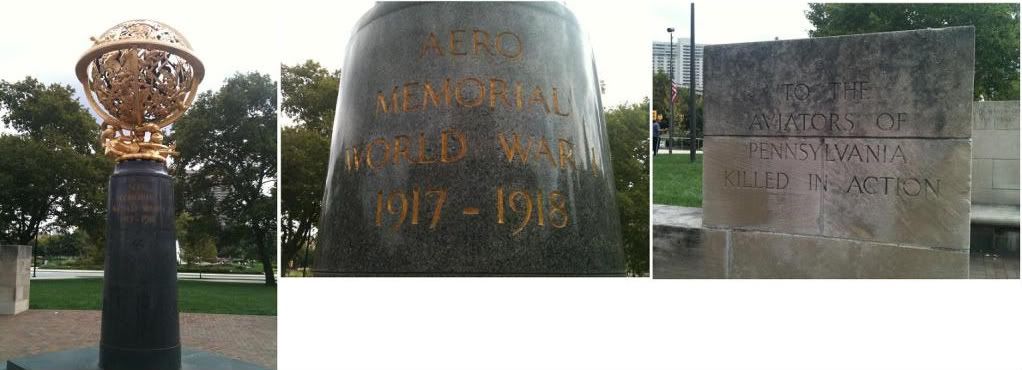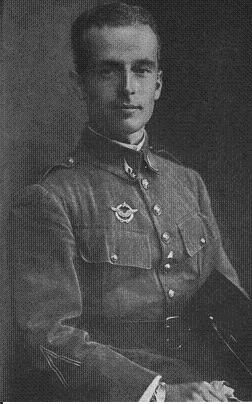I posted this on other forums I belong to but could not get any responses. Does anyone live near any of these and want to post a pic or two?
I went into Philly with my son and showed him this memorial to WWI pilots, this is just a few blocks from my office. It has been refurbished and a memorial wall and lighting surrounds it. Nicely done but I wonder if there are others around the USA or the UK.....anyone know of any? Post the pictures here. A few pilots are listed but some information has degraded over time. The sphere is inscribed with the Latin names of constellations and planets) (Base, front:) AERO/MEMORIAL/WORLD WAR I/1917-1918 (Base, front:) JULIAN BIDDLE/HOWARD FOULKE DAY/(...transcription illegible) ON DOWNS, JR./ (...transcription illegible) CHRISTIAN CLANZ/WILLIAM BESSE KOEN/(...transcription illegible) TON WOODWARD (A plaque with the insignia of the Fairmount Park Art Association appears on the base.)"
I found a photo of Biddle and a bit about him. Still researching the others.


JULIAN CORNELL BIDDLE
In the summer of 1916 he received his Pilot's license at Essington. He was accepted for enlistment in the Foreign Legion, and was sent to the French Military Aviation School at Avord, where he received his brevet and graduated in a very short time. He was then sent to Pau for acrobatics, and on the thirty-first of July he was ordered to Plessis-Belleville for assignment as a battle pilot. On the seventh of August he was sent to Souilly, and afterwards to Dunkirk, where he was assigned to Escadrille Number 73, Groupe de Combat Number 12. On the eighteenth of August, while he was on a practice flight, his plane fell into the North Sea, from an unknown cause. Eight days later his body was washed ashore at Egmond-aan-Zee, North Holland, where the civil authorities reported that it appeared torn by shot. He was buried in the village churchyard at this place. Biddle appears to have been the first American who volunteered after the United States entered the war to be killed at the front. In January, 1918, he was awarded the Aero Club of America medal "for valor and distinguished services"; and he also received the ribbon of the Lafayette Flying Corps. His citation is in the Journal Officiel of July the seventh, 1919.
Biddle's letters from France indicate wide powers of observation, and draw unusually clear pictures of the feverish action and changing circumstances of Paris during the trying months of hurry and distress. He does not conceal the dangers of his task, but thereby proves his superiority to them; and his interest and enthusiasm for his work pervade everything that he writes. Throughout these letters run also the self-reliance and frankness which are so familiar to his friends, whether in facing strange situations or applying himself to his own training. He was able to enjoy whatever social distractions circumstances offered, and dwells with great interest on the chance meetings with friends and fellow-soldiers from home.
Julian Biddle was conspicuous among his schoolmates at St. Mark's for his two characteristics of fearlessness and determination. He, like Mandell, was unaffected by popular opinion as such: he saw clearly beyond the external shows of school spirit and loyalty, and worked hard and impersonally to justify them.
Difficulties meant nothing to him, and whatever opposition he encountered in his straightforward course not only failed to turn him, but did not even disturb him. Such strength of purpose might have been perplexing if it had ever been used capriciously; but it was not. He seems to have had from his early boyhood a solid basis of right thinking, entirely detached from considerations of self, and dedicated to pure principle. When this loyalty was transferred, or rather enlarged, to embrace the duty to his country, it flowered into extraordinary activity and practical efficiency. Five hours of flying won him his Pilot's license, and upon arriving at the flying school at Avord he received his commission in record time. The exact circumstances of his death are not known; but those who know him know that whatever they were, he encountered them as he had encountered everything in his brave life, without a disturbing thought or an instant's hesitation. In his will he showed his love and devotion to his School by leaving to her everything that he had earned in his business since his graduation; but in his life he left St. Mark's far more than money can ever buy: an example of clean loyalty, service, and unfailing sincerity and love.
Also a bit from the Fairmount park commission web site about the memorial.
To commemorate aviators who died in World War I, sculptor Paul Manship created an open bronze sphere that suggests the heavens and the earth, with intricate intertwined forms evoking the signs of the zodiac.
This is an absolutely beautiful memorial to the aviators of Pennsylvania killed in World War I. Please pay particular attention to the wall surrounding the immediate area of the memorial. It is a large sculpture. Its height is approximately 96 inches, the sphere has a diameter of 6 ft. and its base is approximately 116 inches. Paul Manship (1885-1966) was the sculptor and Joseph Patterson Sims (born in 1890) was the architect. The sculpture is made of bronze and limestone or possible granite.
From the sign at the memorial: "Shaped like a celestial sphere, this gilded bronze sculpture is dedicated to Pennsylvania aviators who died in World War I. The outer structure suggests an astronomical instrument, and the figures illustrate signs of the zodiac. Sculptor Paul Manship also created Duck Girl in Rittenhouse Square and Prometheus at New York's Rockefeller Center
First proposed during World War I by the Aero Club of Pennsylvania, the memorial was commissioned by the Fairmount Park Art Association. It was donated to the City of Philadelphia in 1950